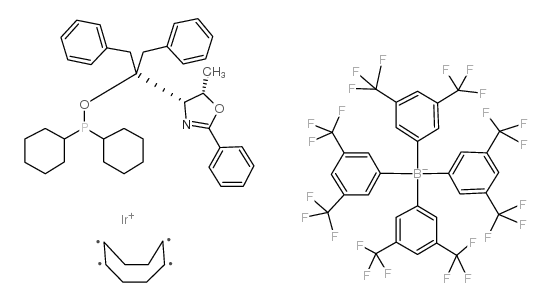583844-38-6
| Name | ((4S,5S)-(-)-O-[1-Benzyl-1-(5-methyl-2-phenyl-4,5-dihydrooxazol-4-yl)-2-phenylethyl]-dicyclohexylphosphinite)(1,5-COD)iridium(I) tetrakis(3,5-bis(trifluoromethyl)phenylborate (S,S)-[COD]Ir[c |
|---|---|
| Synonyms | MFCD06658139 |
| Melting Point | 160-161ºC |
|---|---|
| Molecular Formula | C77H70BF24IrNO2P |
| Molecular Weight | 1731.35000 |
| Exact Mass | 1731.45000 |
| PSA | 44.41000 |
| LogP | 22.55120 |
|
Section 1: Product Identification ((4S,5S)-(-)-O-[Benzyl-1-(5-Me-2-Ph-4,5-dihydro-oxazol-4-yl)-2-PhEt]-dicyclohexylphosphinite)(1,5-COD)Ir(I)te Chemical Name: trakis-(3,5-bis(trifluoromethyl)phenylborate, min. 97% CAS Registry Number:583844-38-6 Formula:Ir(C8H12)(C37H46NO2P)+B[C6H3(CF3)2]4- EINECS Number:none
Chemical Family:organometallic complex Synonym:none Section 2: Composition and Information on Ingredients IngredientCAS NumberPercentACGIH (TWA)OSHA (PEL) Title compound583844-38-6100%2.5mg/m3 (as F)2.5mg/m3 (as F) Section 3: Hazards Identification Emergency Overview:Irritating to skin, eyes and respiratory tract. May be harmful if swallowed. Primary Routes of Exposure:Inhalation, skin, eyes Eye Contact:Causes slight to mild irritation of the eyes. Skin Contact:Causes slight to mild irritation of the skin. Inhalation:Irritating to the nose, mucous membranes and respiratory tract. Ingestion:No specific information is available on the physiological effects of ingestion. May be harmful if swallowed. Acute Health Affects:Irritating to skin, eyes and respiratory tract. Product contains fluorine which under certain conditions of use, decomposition, or metabolism, may generate Chronic Health Affects:fluoride ion, causing, nausea, vomiting, labored breathing, hypocalcaemia, deterioration of bone and tooth structure, kidney and liver damage. NTP:No IARC:No OSHA:No SECTION 4: First Aid Measures Immediately flush the eyes with copious amounts of water for at least 10-15 minutes. A victim may need Eye Exposure: assistance in keeping their eye lids open. Get immediate medical attention. Wash the affected area with water. Remove contaminated clothes if necessary. Seek medical assistance if Skin Exposure: irritation persists. Remove the victim to fresh air. Closely monitor the victim for signs of respiratory problems, such as difficulty Inhalation: in breathing, coughing, wheezing, or pain. In such cases seek immediate medical assistance. Seek medical attention immediately. Keep the victim calm. Give the victim water (only if conscious). Induce Ingestion: vomiting only if directed by medical personnel. SECTION 5: Fire Fighting Measures Flash Point:none Autoignition Temperature:none Explosion Limits:none Extinguishing Medium:carbon dioxide, dry powder or foam. Fire fighters should be equipped with a NIOSH approved positive pressure self-contained breathing apparatus Special Fire Fighting Procedures: and full protective clothing. Hazardous Combustion andIf involved in a fire this material may emit toxic and corrosive fumes. Decomposion Products: Unusual Fire or Explosion Hazards: No unusual fire or explosion hazard. SECTION 6: Accidental Release Measures Small spills can be mixed with vermiculite, sodium carbonate or other suitable non combustible adsorbent and Spill and Leak Procedures: swept up. SECTION 7: Handling and Storage Handling and Storage:Store cold. Handle and store under an inert atmosphere of nitrogen or argon. SECTION 8: Exposure Controls and Personal Protection Eye Protection:Always wear approved safety glasses when handling a chemical substance in the laboratory. Skin Protection:Wear protective clothing and gloves. Ventilation:Handle the material in an efficient fume hood. If ventilation is not available a respirator should be worn. The use of respirators requires a Respirator Respirator: Protection Program to be in compliance with 29 CFR 1910.134. Ventilation:Handle the material in an efficient fume hood. Additional Protection:No additional protection required. SECTION 9: Physical and Chemical Properties Color and Form:orange powder Molecular Weight:1731.35 Melting Point:160-161° Boiling Point:no data Vapor Pressure:no data Specific Gravity:no data Odor:none Solubility in Water:insoluble SECTION 10: Stability and Reactivity Stability:air sensitive, moisture sensitive (store cold) Hazardous Polymerization:no hazardous polymerization Conditions to Avoid:prolonged contact with air Incompatibility:strong oxidizing agents Decomposition Products:nitrogen oxides, hydrogen fluoride, carbon monoxide, phosphorous pentoxide and organic fumes. SECTION 11: Toxicological Information RTECS Data:No information available in the RTECS files. Carcinogenic Effects:no data Mutagenic Effects:no data Tetratogenic Effects:no data SECTION 12: Ecological Information Ecological Information:No information available SECTION 13: Disposal Considerations Disposal:Dispose of according to federal, state, and local regulations. SECTION 14: Transportation Shipping Name (CFR):Non-hazardous Hazard Class (CFR):NA Additional Hazard Class (CFR):NA Packaging Group (CFR):NA UN ID Number (CFR):NA Shipping Name (IATA):Non-hazardous Hazard Class (IATA):NA Additional Hazard Class (IATA):NA Packaging Group (IATA):NA UN ID Number (IATA):NA SECTION 15: Regulatory Information TSCA:Not listed in the TSCA inventory SARA (Title 313):Title compound not listed Second Ingredient:none SECTION 16 - ADDITIONAL INFORMATION N/A |
| Personal Protective Equipment | Eyeshields;Gloves;type N95 (US);type P1 (EN143) respirator filter |
|---|---|
| Safety Phrases | 22-24/25 |
| RIDADR | NONH for all modes of transport |
| HS Code | 28439000 |
